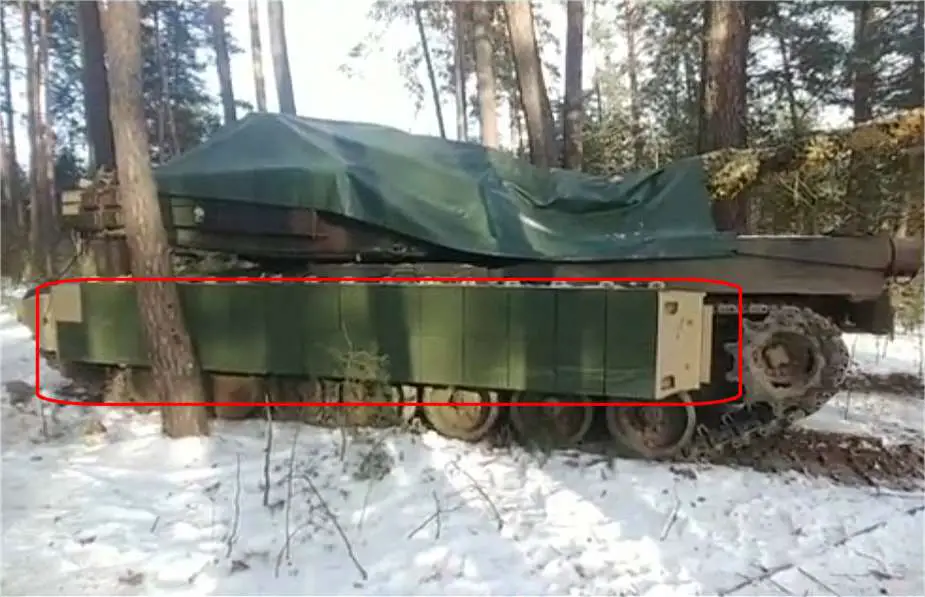- Army
- Conflicts in the world
- Israel - Iran conflict 2025
- Pakistan - India Conflict 2025
- Russia Ukraine War 2022
- Libya conflict day by day
- HAMAS - Israel War 2023
- Operation Serval in Mali French Army
- Sangaris operation Central African Republic
- Sangaris opération militaire République Centreafrique
- Ukraine - Russia conflict
- Syria conflict news
- Defence & Security Industry Technology
- Armies in the world
- Analysis Defense and Security Industry
- Conflicts in the world
- Navy
- Air
Ukraine's US-Donated M1A1 Abrams Tanks Enhanced with Advanced Armor on the Battlefield
Recent images shared on social media, dated January 14, 2024, reveal that the M1A1 Abrams Main Battle Tanks (MBTs), supplied to Ukraine by the United States, have been upgraded with additional armor. This enhancement is aimed at bolstering the tanks' defenses against the evolving threats on the Ukrainian battlefield. Observations from the photographs indicate that the sides of the M1A1 Abrams tanks appear to be equipped with the M-19 Reactive Armor Tile (ARAT), a state-of-the-art armor solution designed to provide superior protection in combat scenarios.
Follow Army Recognition on Google News at this link

Ukrainian M1A1 Abrams MBT Main Battle Tank fitted with additional armor. (Picture source Social Network)
Ukraine has received a total of 31 M1A1 Abrams tanks from the United States, however, there is no public information indicating that these tanks have been equipped with additional armor. These tanks were delivered as part of the military aid provided by the US to assist Ukraine in its defense efforts. The delivery of these tanks was expedited, with the first tanks arriving in Ukraine in late 2023. This decision to provide M1A1 tanks, instead of the more modern M1A2 variants, was made to facilitate faster delivery and to align with the capabilities and logistical support available in Ukraine.
The M1A1 Abrams tank, an improved version of the M1 Abrams, is equipped with sophisticated composite armor for protection. This armor, known as Chobham armor, is a composite armor that incorporates materials such as ceramics and metal alloys. The specifics of the armor's composition are classified, but it's known for its effectiveness against a variety of anti-tank threats, including kinetic energy penetrators and chemical energy heat rounds. The Chobham armor is a significant aspect of the M1A1 Abrams, contributing to its reputation as a highly protected main battle tank. This advanced armor system is a key feature that has been consistently upgraded in various versions of the Abrams tanks to enhance their battlefield survivability.
The M-19 Abrams Reactive Armor Tile, developed by EBAD in the United States, represents cutting-edge armor technology. This tile merges EBAD's specialized insensitive energetic materials with passive components, offering a substantial increase in armor protection while being notably lighter than traditional steel appliqué armor options.
The protective mechanism of this tile is based on Explosive Reactive Armor (ERA), which involves cassettes comprising an explosive layer sandwiched between two metal plates. This innovative configuration significantly enhances the survivability of vehicles against various threats, contributing to reduced soldier casualties and bolstered vehicle mission capabilities. Further information on this technology is available upon request.
Since 2006, the U.S. Army has fully implemented the M-19 module in response to the risks heavy tanks faced from insurgents in Iraq. The M-19's modular and lightweight design allows for manual installation, facilitating easy application and adaptation based on changing battlefield conditions or specific mission needs. It can be applied to various parts of a vehicle, such as the hull, skirt, or turret, offering enhanced protection against shape charge threats, particularly in urban combat scenarios.
Notably, the M-19 technology is highly reliable and has maintained a clean safety record across training, field operations, and combat situations. It does not require maintenance, power, or sensors, and its handling requirements are akin to those of ammunition, allowing for joint handling and storage. The design minimizes collateral damage, with rigorous analysis and testing ensuring the prevention of adjacent module detonation during an attack and directing the response towards the incoming threat.
This armor system complies with MIL-STD 2105 IM requirements and has undergone extensive testing against small arms to verify its insensitivity to bullet and fragment impacts. It is also fully self-extinguishing, adding another layer of safety and reliability to its design.
News Russia Ukraine War


























